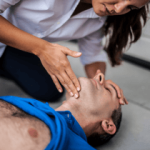Is Your Baby Gagging or Choking

When you are starting solids with your little one, if you are anything like me, you made everything into a watery consistency because you were terrified of them choking! (yes, even though we are the ‘experts’, that does not mean we don’t have the same fears as any mum!)
Is it normal for babies to gag when starting solids?
When your baby is gagging, it is a contraction of the back of the throat and is triggered by an object touching the roof of the mouth, the back of the tongue or near the back of the throat. It starts off quite sensitive when the baby is very young but becomes less sensitive as your baby gets older.
There are a few distinct differences between gagging and choking.
Gagging Symptoms:
- The child may have watery eyes
- They will momentarily have their mouth wide open
- They may make gagging noises
- They thrust their tongue forward
- Sputtering and a normal productive cough
- They may seem frustrated
- they may vomit
- Face will be red or very pink
- Overall gagging is normally quite short lived, a few seconds.
- The overarching advice with gagging is Do Not Interfere.
This is the same as when they may be choking on something, IF they have a good productive cough, just get them out of their chair, sit them on your lap and support them, sit upright and let them cough. If their cough is weak or there is no noise at all, we need to call an ambulance and start first aid.

Most of the time they will cough the object/food up or vomit it up. Below are the signs and symptoms of a child choking. It can be completely silent.
Symptoms for Choking:
- They colour may be pale, purple or blue tinged
- they be making a noise when they breath/wheeze
- They may have a weak cough
- They may be unable to make a ny noise
- they may look wide eyed & panicked
- Staring and open mouthed for longer
- May wave arms or grab at throat
- Gasping for breath
Choking Infant First Aid
If the child starts to cough, it is best to remove the child from the highchair or wherever they are, and support them sitting up on your lap.
If they have a good productive cough, just support them and keep them upright.
This is when the object is usually dispelled.
If the cough starts to become weak or there is a noise when they are breathing, we need to call emergency services and start first aid.
Baby First Aid for Choking
Check the airway – If you can see a foreign object, and it can easily be removed with your forefinger and thumb, you can try to remove it. DO NOT use your finger to sweep the mouth or touch anything further down the back of the throat.
If there is fluid or vomit in the mouth, roll the child on their side and let the fluid drain out.
If there is nothing in the mouth but the child has a weak cough or noisy breathing, back blows should be started.

Choking Chest Thrusts
Position the child over your lap, face down. Support the head by placing your hand under the chin to keep the head in a neutral position.
Administer 5 back blows with the heel of your hand, between the shoulder blades with a short sharp blow, turning the head slightly to check the mouth in between blows. It can only take one of two back blows to remove a foreign body from the airway, so we don’t want to continue with the back blows if the child then has the object in their mouth as it may end up back in the throat.
If the child’s condition remains the same, with a weak cough or noisy breathing, turn the child over so that they are laying on their back on your lap or on the floor. Commence chest thrusts.
For chest thrusts, use two fingers (infant) or the heel of one hand (age 1-8 years). Place in the centre of the chest between the nipples, and give a short sharp push down, approx ⅓ of the depth of the chest. This is similar to CPR but slower. Between chest thrusts, check the child’s mouth.
If the child still remains the same, turn them back over and commence back blows again. Continue to alternate 5 back blows and 5 chest thrusts until the child recovers or emergency services arrive.
If a child stops breathing at any time, commence CPR.
Baby First Aid Course
Our baby first aid courses are available in person in your home and online.
We run classes in your home with groups of 2, 4 or up to 10 in Sydney & Melbourne and you can book in 3 easy steps!
- Pick your class
- Follow the prompts to purchase
- We will contact you within 24 hours to lock in your date of choice
Here are some other resources you may enjoy!
– FREE GUIDE: Introducing Common Allergy Foods & Allergic Reactions
– Book a baby & child first aid class in your home
– Online Baby & Child First Aid
– Follow us on Instagram and Facebook
Keep in touch and email us with any queries!

